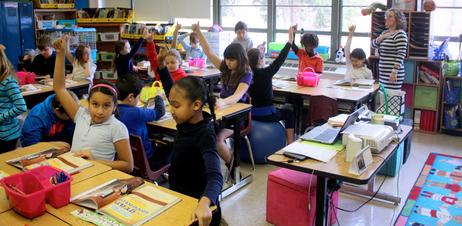While the unjust days of official segregation ended 40 years ago, public schools today are struggling against another type of segregation: racial isolation. Public schools in both urban and rural areas have been experiencing racial isolation, which occurs when one district is densely populated by a predominant ethnic group.
To combat these geographically-induced segregation trends, public school leaders have created integration programs to develop more diverse student populations. While the concept of mandatory racial integration may sound strange to an unfamiliar ear, schools across the country have implemented “reassignment” programs to increase diversity. In many cases, public schools have enforced specific race-based quotas – and these practices have ignited controversy on both sides of the debate.
From the Library of Congress: "The massive effort to desegregate public schools across the United States was a major goal of the Civil Rights Movement. Since the 1930s, lawyers from the National Association for the Advancement of Colored People (NAACP) had strategized to bring local lawsuits to court, arguing that separate was not equal and that every child, regardless of race, deserved a first-class education. These lawsuits were combined into the landmark Brown v. Board of Education Supreme Court case that outlawed segregation in schools in 1954. But the vast majority of segregated schools were not integrated until many years later. Many interviewees of the Civil Rights History Project recount a long, painful struggle that scarred many students, teachers, and parents."
Chicago Public Schools: Mandatory Racial Integration
Gaining a major spotlight in national news are public schools in Chicago, who redesigned their enrollment practices to diversify their student population, according to the Chicago Tribune. However, these changes have ignited a frenzy of media and legal attention.
In late September of 2009, a federal judge ordered Chicago public school leaders to end their mandatory racial integration efforts, citing that the practices were inadvertently causing unjust treatment and social malfeasance. The judge's decision, although welcomed by many educational leaders and community members, “presents district officials with a quandary increasingly shared by urban districts across the nation: how to achieve racial equality without making explicitly race-based decisions.”
In examining Chicago's race-based school assignment practices, the schools most recognized for enforcing racial quotas were many of the district’s 75 magnet schools, wherein at least 65 percent of the school's classroom seats were designated for minority students. Similarly, approximately 35 percent of classroom seats were reserved for Caucasian students; however, the prevalence of Caucasian students has gradually diminished, and statistics show that Caucasian students only make up 8 percent of the student population of the magnet schools.
Chicago school leaders argue that their racial “standards” for schools were designed to de-segregate many of the primarily Caucasian and minority schools in the city. As a result of the recent judgment to end these practices, “Critics fear the decision will cripple efforts to integrate the district and point to other cities that have seen a school system become re-segregated once court-ordered integration ended.” Adding more concern to this fear, many community members are worried that the magnet and elite schools will gradually become “bastions for the wealthy white.”
Examining the Nation: Are Schools Still Substantially Segregated?
The controversy Chicago public schools face is not new. In fact, San Francisco's Unified Public School District was forced to make similar policy changes in decades past. As early as 1983, leaders of San Francisco public schools mandated the “Elimination of racial/ethnic segregation or identifiability in any school, program, or classroom to the extent practicable.”
However, plaintiffs in 2001 brought a complaint to the court, asserting that the public schools of San Francisco were in violation of the United States’ “Equal Protection Clause.” The plaintiffs argued that students attending some of San Francisco’s public schools were being discriminated against based on their race. The District Court approved an agreement between the plaintiffs and the schools to ensure that leaders would, “Take all practicable actions to eliminate existing segregation and vestiges and past segregation.” Ultimately, this settlement prohibited school leaders from using race as a determining factor to assign students to specific schools and classrooms.
Racial isolation continues to be an issue that public schools in America face. As schools across the country struggle to create more diversified student populations, controversy is certain to rise again.
This TEDTalk discusses the impact of desegregation on schools.
The children de-segregated America's schools.
In an article in The Atlantic, Rebecca J. Rosen notes that: "In 1954, the Supreme Court decided that segregation of public schools was unconstitutional—but it was thousands of children who actually desegregated America’s classrooms. The task that fell to them was a brutal one. In the years following Brown v. Board of Education, vicious legal and political battles broke out; town by town, Black parents tried to send their children to white schools, and white parents—and often their children, too—tried to keep those Black kids out. They tried everything: bomb threats, beatings, protests. They physically blocked entrances to schools, vandalized lockers, threw rocks, taunted and jeered. Often, the efforts of white parents worked: Thousands upon thousands of Black kids were barred from the schools that were rightfully theirs to attend."
Questions? Contact us on Facebook. @publicschoolreview















